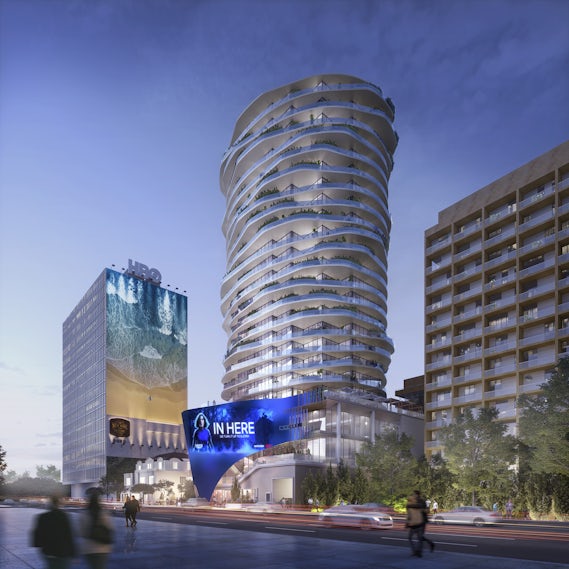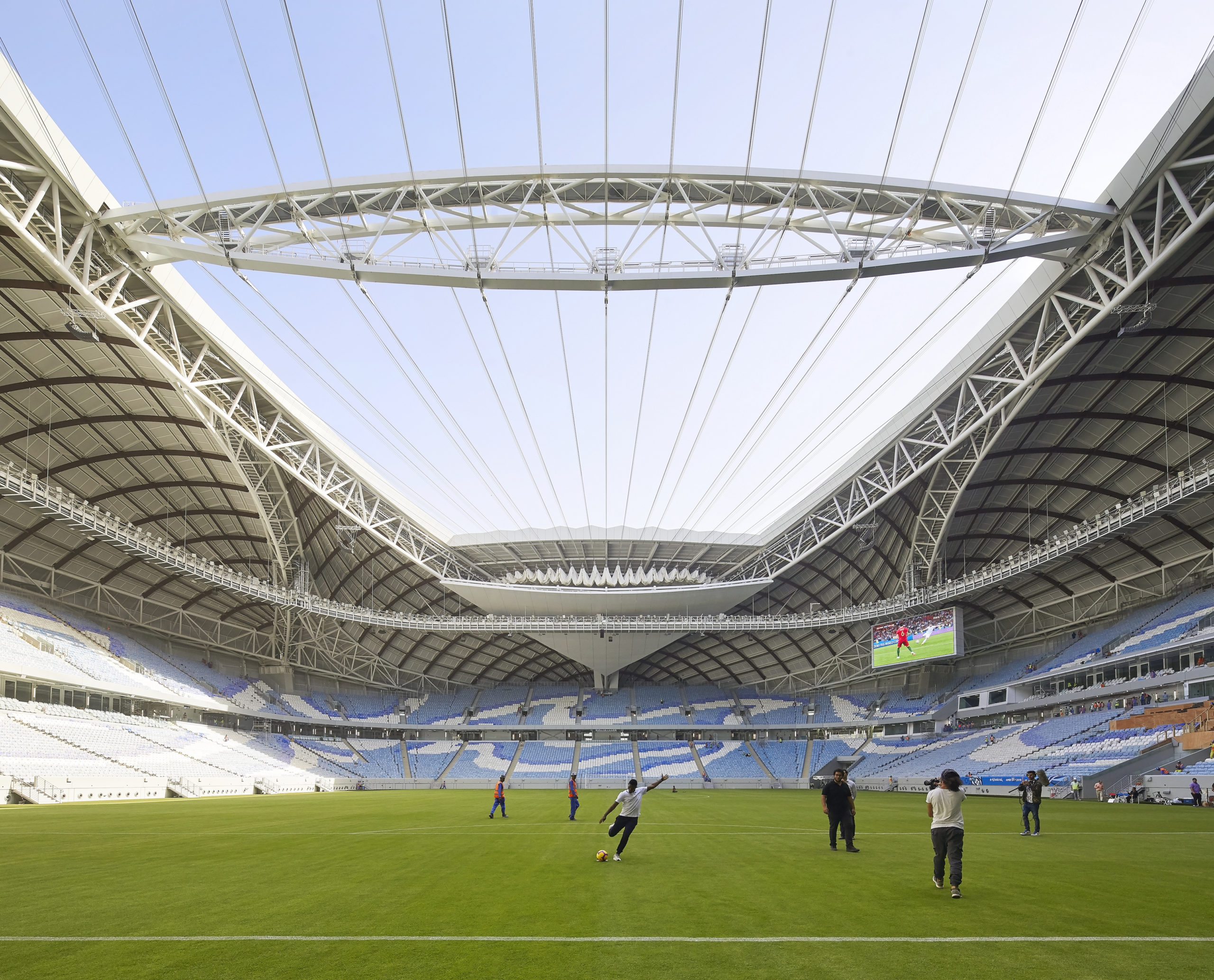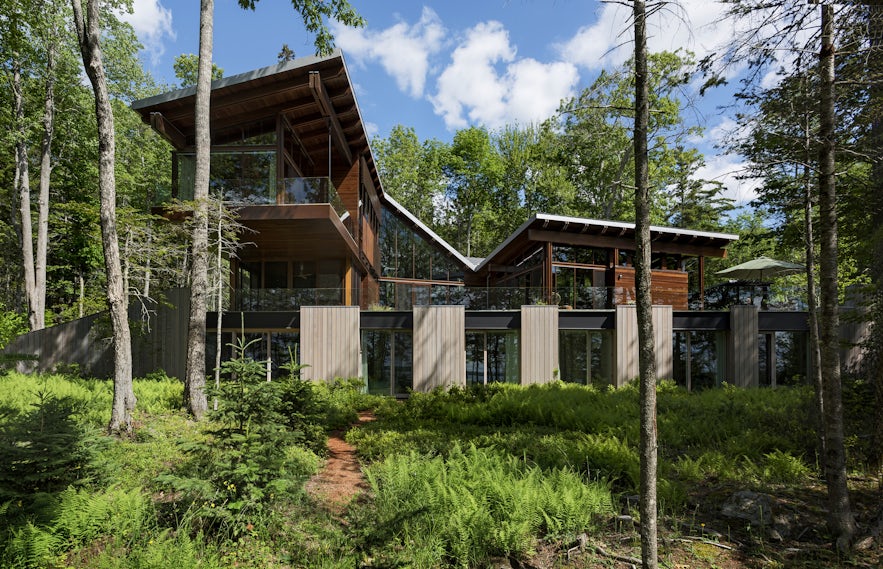Tower on Sunset – The project is a 24-story mixed-use tower with residential units (109 market-rate, 47 inclusionary), amenities, outdoor space, office, retail/restaurant, and an interactive digital sign. Building on the culture and history of Sunset Blvd., the Tower on Sunset was formed around iconic views of West Hollywood and Los Angeles. These view corridors define the tower and generate the sculptural nature of its curving floor plates. The design embraces the history of one of L.A.’s most iconic streets and reimagines the tower typology to capture the essence of the city itself. The project site also contains the historic Crosby building, Bing Crosby’s former office, designed by Ronald J. Webb in 1937. This historic California landmark will be relocated on-site. The project is currently in the Entitlement process in West Hollywood and continues to evolve with input from the city and its residents.
Architizer chatted with Michael Contento, Design Director at OFFICEUNTITLED, to learn more about this project.
Architizer: What inspired the initial concept for your design?
Michael Contento: The design was inspired by the character and energy of Sunset Boulevard and its rich history of rock and roll and creative expression. The project also embraces the southern California climate through extensive outdoor spaces, expansive private balconies, and connections between indoor and outdoor spaces. The cantilevering balcony edges form an undulating façade that frames continuous views of the city and generates a sculptural form that reflects the dynamic nature of West Hollywood. Programmed around the city’s metropolitan activity, the mixed-use project builds upon the spirit of surrounding staples like the Roxy Theatre, the Rainbow Room, and the Shamrock Social Club.

© OFFICEUNTITLED

© OFFICEUNTITLED
This project won in the 10th Annual A+Awards! What do you believe are the standout components that made your project win?
The most striking component of the project is the sculptural nature of the perceived rotation of the tower. In addition to capturing the energy and dynamic quality of the Sunset Strip, the shifting balcony extensions also provide multiple benefits to the project and users related to use, sustainability, and orientation. By utilizing the rounded form, the tower minimizes impacts on existing view corridors while fitting within a challenging site. Each floor plate also acts as a shading device for the outdoor spaces that wrap the building, providing opportunities for protected indoor/outdoor living and natural ventilation.

© OFFICEUNTITLED
What was the greatest design challenge you faced during the project, and how did you navigate it?
The project is situated on an irregular T-shaped site with over 20’ of grade change. With tall buildings on both sides of the property and an existing historical resource on-site – the Crosby Building, designed by Ronald J. Webb in 1937 – managing site circulation, building orientation, massing, open space, and the proposed digital signage became a primary challenge. The elliptical tower form and overall project layout into four main components – tower, activated urban edge, historical building, and low-rise component at the south end of the site – helped balance these elements.

© OFFICEUNTITLED

© OFFICEUNTITLED

© OFFICEUNTITLED
How did the context of your project — environmental, social or cultural — influence your design?
Much of our work is influenced by the climate of southern California and the ability to integrate indoor and outdoor spaces. The floor plates extend beyond the face of the building to create a continuous outdoor space on each floor and to self-shade the building. The continuous outdoor spaces also provide iconic views throughout West Hollywood and Los Angeles, connecting the project to its broader context.
We also see the tower as a vertical expression of the Sunset Strip, capturing its dynamic and evolving character. The ground floor also pulls back from the street to create a large open space that brings the street activity into the project and creates a space for interaction.
This project also includes 47 affordable-income residential units (30%) in addition to market-rate units, which exceeds the affordable housing requirement in West Hollywood.

© OFFICEUNTITLED
What drove the selection of materials used in the project?
The undulating floor plates capture the primary design goals of the project in a single element – sustainability through self-shading and natural ventilation, outdoor space through wrap-around balconies, livability through the integration of indoor and outdoor space, views through strategic rotation and placement, and sculptural form.
How important was sustainability as a design criteria as you worked on this project?
OFFICEUNTITLED sees sustainability as an essential and evolving goal for all our projects. In this case, we addressed sustainability in a few ways – ecological, social, economic, and cultural. The project utilizes self-shading devices, natural ventilation, drought-tolerant landscaping, outdoor spaces, low-water use, energy-efficient appliances, and recycled/recyclable materials to meet and exceed the West Hollywood Green Building Program requirements. The project also exceeds the city’s affordable housing requirement to address the need for more affordable housing. Large outdoor spaces on the ground floor provide space for activity and interactions on the street to move onto the site. And the historic Crosby Building will remain on site as a landmark of the Sunset Strip’s long history and bright future.
In what ways did you collaborate with others, and were there any team members or skills that were essential in bringing this Award winning project to life?
The design and Entitlement process is still ongoing, and collaboration is essential to the project’s success – with project consultants, the City of West Hollywood, local neighborhood groups, and residents. Each source of input, from experts to planning staff to community members, is vital to the design process and helps inform the project.
Because the project prioritizes outdoor space, the input from the landscape architecture team was vital in creating spaces that will be used and activated while remaining environmentally responsible.

© OFFICEUNTITLED
Were any parts of the project dramatically altered from conception to construction, and if so, why?
With the project still in the Entitlements phase with the city of West Hollywood, the design process is still ongoing. Still, several aspects of the project have changed significantly to accommodate evolving project needs. The program changed from a hotel to a mix of hotel and residential units and finally to the current program of apartments, offices, and retail/restaurant spaces. The tower also began with a more circular form. As the design process progressed, we realized that the current elliptical shape would allow us to balance project goals, needs, and requirements more productively. The site circulation also started with a more traditional form, with a drop-off near the front of the site along Sunset Blvd. However, bringing the site circulation further into the site allowed us to create more substantial outdoor space along Sunset Blvd. while maintaining a logical traffic flow.
How have your clients responded to the finished project?
The ownership team has embraced the design goals that transform this project from a standard tower typology into something more iconic, usable, and sustainable for the Sunset Strip. They are looking forward to continuing our engagement with the city and neighborhood.
What key lesson did you learn in the process of conceiving the project?
The project size and location in West Hollywood require a relatively long design and Entitlements process. That increased time has allowed the design to evolve to address and meet the ever-changing project requirements and needs. It’s a great reminder that projects and project teams can always learn from the site, context, and program at any point in the process by constantly questioning and keeping an open mind.

© OFFICEUNTITLED
How do you believe this project represents you or your firm as a whole?
After Bay point Landing, this is our second A+Award. Each award has resulted in increased exposure and positive response from other architects and clients, as well as students and future architects interested in how design shapes our cities.
How do you imagine this project influencing your work in the future?
This project has been in the office for a while and, in a way, has been the recipient of beneficial lessons from other projects throughout its life. But it also serves as an example of our constant search for something new and surprising. The enduring value of the project and its design process is understanding how to translate the unseen or unexpected into workable design solutions that address the many needs of projects at this scale.
Team Members
Christian Robert, Principal in Charge, Michael Contento, Design Director, Wilson Chang, Project Architect, Carlos Maya, Senior Designer, Jeff Mikolajewski, Designer, Tingting Xu, Designer, Stephen Clipp, Designer, Lecan Li, Designer, Teresa Martin-Rico, Designer, Tam Tran, Designer, Yijie Liu, Designer, Taylor Halamka, Designer, Kyle Smith, Designer, Merve Onur, Designer, Luca Scherraus, Designer
Consultants
SWA – Landscape Architect, Kurt Fischer Structural Engineering – Structural Engineer, VCA – Civil, ACE – MEP, Walter P. Moore – Traffic, Buehler – Parking, SGH – Code Consulting
For more on Tower on Sunset, please visit the in-depth project page on Architizer.









 Tower on Sunset
Tower on Sunset 


